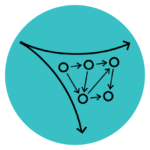The recovery of the central role and significance of Jesus for discipleship, spirituality, theology, community, and mission.
Jesus is Lord – * A radical and unwavering commitment to the Way (ethos) of the Founder Jesus at the very center of it all;
Rather than maintaining a generic “Jesus is Lord” confessional intent or promotion of badge or brand, leaders cultivate a clear and compelling vocabulary and focus that declares their identity and intent as the radical minimum standard of following Jesus together.





